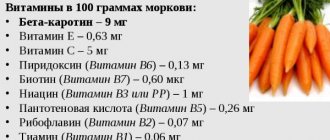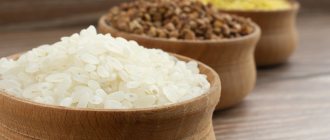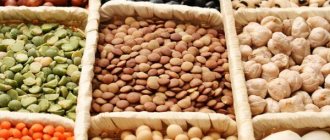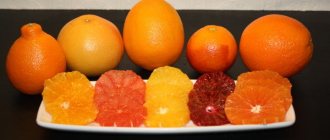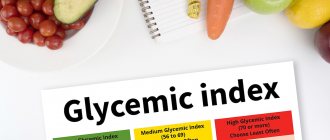Glycemic index of cereals
Cereals are important sources of energy, healthy dietary fiber, B vitamins (B1, B2, B3 (PP), B4, B5, B6 and B9), E, K and trace elements (calcium, sodium, phosphorus, magnesium, iron, manganese, zinc, cobalt, etc.) 1. Recommendations for creating a diet for people with diabetes advise making cereals, along with proteins, fats and “free” carbohydrates, the basis of the diet 2.
When choosing side dishes, it is worth considering the glycemic index of each individual variety of cereal.
What is glycemic load
Current research, including from Harvard University, shows a strong relationship between a high index (HI) diet, a high glycemic load (GL) and the incidence of insulin resistance, the incidence of type 2 diabetes and increased insulin requirements in patients with type 1 diabetes.
There has been a proven relationship between the consumption of high GI foods and an increased risk of breast and colorectal cancer.
Glycemic load GL (GL) is defined as a way of assessing the carbohydrate content of food. This indicator is based on two variables, namely the glycemic index (GI) value and standard serving size. The concept of glycemic load was introduced in 1997 by scientists at Harvard. This is the glycemic response of the body after eating a certain amount of food. Another term for GL is glycemic density.
Glycemic index - what is it?
The glycemic index (GI) is a ranking of carbohydrates on a scale of 0 to 100 based on how much they raise your blood sugar (glucose) levels after a meal. The standard in this classification is glucose, which has a GI of 100.
High GI foods are quickly absorbed, digested, absorbed and metabolized in the gastrointestinal tract. They lead to noticeable fluctuations in blood sugar (glucose) levels. Low GI foods cause less intense and slower increases in glucose and insulin levels.
Grinding, fine grinding, prolonged cooking, and treatment with auxiliary substances during the preparation of cereals can significantly increase its GI.
How does the glycemic index affect weight loss?
Insulin is a pancreatic hormone that affects metabolic processes in almost all tissues. Regarding our topic, you need to know that insulin is a “transporter” that delivers glucose from carbohydrates obtained with food to the cells of our body. Insulin begins to be produced in response to the appearance of glucose in the blood.
But insulin works in two ways. On the one hand, it helps glucose accumulate as energy (this can be either glycogen or fat). On the other hand, inulin prevents the breakdown of glycogen and fat into glucose. That is, the hormone insulin in every possible way contributes to the preservation of all three types of fats in your body.
What happens when we eat a low or high GI food? As I already wrote, the low glycemic index of a product indicates that it slowly increases blood sugar levels. This means that insulin production occurs slowly, glucose is distributed rather slowly into the cells, glycogen in the muscles and liver is also formed slowly and is therefore used as energy to cover the body’s current energy costs over a long time.
In turn, a high glycemic index of a product quickly increases blood sugar levels. This means that insulin is produced quickly and in larger quantities. In a short period of time, a large amount of glycogen is synthesized in the muscles and liver, which can give you a lot of strength and energy right now. Those. if you ate, for example, several dates, which have a high GI, and started training, then you will get a lot of energy for the workout. But if, after eating, you simply go to watch TV, then so much energy will not be useful, there is much more of it than you need at a given period. Therefore, excess energy will begin to be converted and stored as fat.
Let me sum it up. If you need a quick boost of energy right now, then high GI foods are the best option. But if this is not the case, then it is better to eat foods with a low GI and supply the body with energy slowly, without provoking insulin surges and, as a result, fat accumulation. Accordingly, if your goal is to lose fat, then your diet should be dominated by foods with low and medium GI.
Factors that increase the glycemic index
Eating carbohydrates causes the body to respond by changing blood sugar levels. There is a group of foods with high GI. Food processing, that is, the way they are prepared, also affects the increase in GI.
Example: long-term boiling of starchy foods in water causes a change in their structure. A slurry begins to form, the degree of stickiness of which depends on the amount of amylose in the product. The less it is, the faster the product is digested, which means the level of glucose in the blood quickly increases.
Typical foods with a low amylose to amylopectin ratio are rice, potatoes, and wheat flour.
Factors that increase GI are:
- high content of table sugar in foods (aka sweet poison);
- low protein, fat and fiber content;
- cooking;
- frying;
- grinding food;
- grain cleaning;
- high ripeness of fruits.
Important : overeating also increases GI.
Dependence of the glycemic index of a product on the method of its preparation
- A large amount of fat in a dish can slightly reduce the GI. So if a product with a high GI was fried in oil, its glycemic index decreased.
- Baking and grilling increase the GI of foods rich in resistant starch by breaking it down. Therefore, for products with resistant starch, cooking in water is most suitable, as it does not lead to the breakdown of complex carbohydrates.
- The longer foods such as pasta or rice are cooked, the higher their GI becomes.
- When assessing the GI value of fruits, it is important to take into account their ripeness. The more ripe the fruit, the higher its GI. This is especially clearly noticeable on bananas, the index of which can range from 30 to 51 depending on ripeness.
Why do you need the glycemic index of foods?
Good and bad carbohydrates
Most diets are somehow focused on eliminating something from the diet.
For a while this usually works. But if you stick to a diet for a long time, you can do quite a lot of harm to the digestive system and the body as a whole. Avoiding one of the nutrients, be it fats or carbohydrates, is not a good idea. It’s better to figure out which foods will bring more benefits for the same calories. The Lifehacker Telegram channel contains only the best texts about technology, relationships, sports, cinema and much more. Subscribe!
Our Pinterest contains only the best texts about relationships, sports, cinema, health and much more. Subscribe!
Carbohydrates are the main source of energy for humans. Once in the body, carbohydrates are converted into glucose, which is used by cells for energy. Delivery occurs using the transport hormone insulin. If there is not enough insulin, blood sugar levels rise. In response to this, a healthy body produces more insulin until the sugar level returns to normal.
But there's a problem: when insulin levels are high, nutrient delivery exceeds the cells' needs. This means that everything unnecessary is put aside in reserve.
There is another negative aspect of sudden spikes in sugar levels. Have you noticed how eating candy improves your mood? But the effect does not last long: rarely more than half an hour. Immediately after the release of insulin, your mood drops and you reach for a new portion of sweets. You can swing this swing all day long, creating an addiction to sugar.
Vaicheslav/Depositphotos.com
Therefore, it is generally desirable that the insulin rises smoothly. Here we come to the concept of the glycemic index.
Glycemic index of foods
The glycemic index (GI) is a characteristic of a food that shows how much it will increase blood glucose levels compared to pure glucose. A glycemic index of more than 70 is considered high, and less than 35 is considered low.
| High GI | Average GI | Low GI |
| glucose, white bread toast (100) | pineapple, banana, melon, black bread, jacket potatoes (65) | dried apricots, raw carrots, pear (35) |
| bun, baked potato (95) | boiled rice, canned corn (60) | peach, apple, milk (30) |
| corn flakes, popcorn, white bread, stewed carrots (85) | oatmeal cookies, milk oatmeal, spaghetti, buckwheat, kiwi (50) | dark chocolate, pearl barley, cherry, plum (22) |
| crackers, chips (80) | pineapple juice, bran bread (45) | peanuts, apricot (20) |
| watermelon, zucchini, pumpkin (75) | boiled beans, grapes, apple and orange juices (40) | walnuts (15) |
| sugar, milk chocolate, cola (70) | eggplant, pepper, cabbage (10) |
It would seem that everything is simple: you need to exclude foods with a high glycemic index (GI > 70) from the menu. With buns and chips, everything seems to be clear. But at the same time, foods such as baked potatoes, stewed carrots, watermelon, pumpkin and zucchini also have a high GI. And the same sugar has a GI of 70.
It turns out that it is healthier to eat sugar than vegetable stew?
Of course not. To create a menu taking into account the glycemic index, you need to remember that the percentage of carbohydrates in foods is different:
| Product | Glycemic index (GI) | Percentage of carbohydrates |
| baked potato | 95 | 11,5 |
| stewed carrots | 85 | 29 |
| watermelon | 75 | 8,8 |
| pumpkin | 75 | 4,4 |
| zucchini | 75 | 4,9 |
But sugar is 100% a carbohydrate!
Simply multiplying these values gives the glycemic load (GL) of the product:
| Product | Glycemic index (GI) | Glycemic load (GL) |
| baked potato | 95 | 11 |
| stewed carrots | 85 | 25 |
| watermelon | 75 | 7 |
| pumpkin | 75 | 3 |
| zucchini | 75 | 4 |
| sugar | 70 | 70 (!) |
This concept already better characterizes the products.
| Glycemic load (GL) | Products |
| > 70 | honey, sugar |
| 60–70 | corn flakes, white bread toast, jam, popcorn, bun |
| 30–60 | rice, crackers, shortbread, couscous, millet, raisins, white bread, oatmeal cookies, chips, milk chocolate, spaghetti, donut |
| 10–30 | cola, croissant, black bread, stewed carrots, jacket potatoes, dried apricots, dumplings, buckwheat, banana, mashed potatoes, dark chocolate (70% cocoa), baked potatoes, ice cream |
| < 10 | boiled beans, fruit juices, pineapple, watermelon, milk oatmeal, mango, grapes, melon, beets, pearl barley, figs, zucchini, pumpkin, pear, orange, peach, walnuts, raw carrots, cherry, apple, plum, kiwi, strawberry , peanuts, apricot, milk, grapefruit, Greek yogurt, eggplant, bell pepper, broccoli, tomato, mushrooms, lettuce |
It can be seen that familiar healthy foods generally have a low glycemic load. There is no point in excluding them from the menu: carrots and porridge are still as healthy as they were in the last century. And I think you understand everything about cookies and buns even without nutritional terms...
Nothing new: there are no magic products. To lose weight, you need to burn more calories than you consume. Science does not stand still, but carrots are still healthier than candy.
However, the glycemic index is not a useless concept.
How to use the glycemic index
- Low GI foods provide a long-lasting feeling of fullness, but it is difficult to feel full at lunch. Therefore, low GI products in the classic menu are supplemented with high GI products, for example: meat with mashed potatoes or nuts with honey.
- High GI foods are not harmful. But they are appropriate when you are using energy intensively. For example, during a long run or immediately after cleaning. But a piece or two of cake while watching a movie in the evening will definitely not do any good.
- It is worth considering that the cooking method affects the GI value: the smaller the pieces and the longer the heat treatment, the higher the GI. For example:
| raw carrots (35) | vs | stewed carrots (85) |
| jacket potatoes (65) | vs | mashed potatoes (90) |
To select the appropriate carbohydrates for your situation, use a table in which foods are sorted by glycemic index value, and the glycemic load is indicated by color.
Calculation formula
Glycemic load (GL) is calculated using the following formula: glycemic index (GI) * amount of carbohydrates per serving / serving size.
The amount of carbohydrates in food can be found either from special tables or seen on the product packaging. The manufacturer indicates the amount of nutrients per 100 g.
It is quite difficult to calculate the glycemic index of various food products yourself; this is done by specialists. They compile the corresponding tables.
A glucose load with indicators of more than 20 units is considered high, from 10 to 19 - average, less than 10 - low.
Glycemic index
The GI of each product is compared with the GI of glucose taken in its pure form, which is 100 units. The absorption of glucose in this case is only absorption: partial in the upper gastrointestinal tract and main in the small intestine. There are a huge number of information and reference tables in which food products are divided into three groups: with low, medium and high glycemic index. In order to correctly interpret data on the GI of products, you need to know that the GI value of the same product depends on a number of factors and conditions:
- on the ratio of proteins, fats, carbohydrates in the product: higher GI in products in which the ratio is shifted towards carbohydrates (fruits, confectionery)
- on what kind of carbohydrates are in the product: “fast” (granulated sugar, beer) or “slow” (cereals, vegetables), and it is also important how much fiber is present in the product (fiber is a polysaccharide, but is not digested, and performs other functions, for example, reduces the activity of amylases and reduces the rate of digestion of food (bran, legumes, vegetables, fruits))
- on the ratio of amylose and amylopectin in starch: the lower the % of amylose, the higher the GI (potatoes), the higher the % of amylose, the lower the GI (lentils and other legumes)
— on the degree of ripeness of the product: the higher it is, the higher the GI (bananas)
- under what conditions and for how long was the product stored: freezing in some cases leads to a decrease in GI (bread), repeated freezing / thawing leads to partial breakdown of carbohydrates and an increase in GI (vegetables), long-term storage leads to “aging” of the product and an increase in its GI (potato)
- from the technological features of production: extrusion and “plasticization” in the production of pasta reduces GI, and hand-made pasta has a high GI (noodles)
- on the methods of processing and preparing the product: grinding, homogenization increase GI (mashed potatoes, etc.), prolonged heat treatment also leads to a significant increase in GI during the cooking process (cooking pasta for more than 5 minutes, boiling vegetables instead of steaming)
Persons diagnosed with diabetes mellitus need to balance their diet and adjust their diet to ensure quality of life and prevent late complications. When choosing food products for workdays, weekends and holidays, it is recommended to take into account the glycemic index of foods. When using foods with a high glycemic index, you should strictly regulate their quantity, regularly measure blood glucose levels, take medications on time and/or administer the hormone insulin.
Taking care of you and your health, Di&Di Corporation LLC
Nutritionist, specialist in the field of clinical and laboratory diagnostics, head. laboratory and scientific consultant of Di&Di Corporation LLC Ivanova L.V.
Why the glycemic index of foods is important for weight loss
In response to the intake of different complex carbohydrates, blood sugar levels rise in different ways.
The glycemic index reflects how much certain foods increase blood glucose levels and how long the increase lasts.
Currently, GI has been calculated for a huge number of products. And depending on the value of this parameter, they are all divided into three categories:
- products with high GI – from 70-100;
- with average – 50-70;
- with low – below 50.
When we eat foods with a high GI, blood sugar rises quickly and significantly. After a meal with foods with low GI, the level of glucose in the blood also increases, but not quickly and not much.
That is, the glycemic index reflects how quickly food in the body turns into sugar.
In response to increased blood glucose levels, the pancreas synthesizes insulin. And the more sugar in the bloodstream, the faster and in greater volume insulin is released.
Moreover, it is high levels of insulin that underlie many serious human diseases, including excess weight gain and obesity.
You can learn how insulin contributes to the formation of excess fat deposits in this article from the section “High Insulin Levels Lead to Obesity.”
When there is a lot of insulin, blood sugar levels drop very quickly. Hypoglycemia begins. As a result, the person again attacks food. And this behavior leads to further weight gain and poor health.
Low GI foods do not lead to a significant release of insulin and, therefore, are not a cause of obesity. The body after them is in a healthier and more stable state.
Glycemic Index vs. Glycemic Load
The glycemic index (GI) assigns a numerical rating to a food based on how dramatically it raises your blood sugar levels. Foods are ranked on a scale from 0 to 100, with pure glucose (sugar) given a value of 100. The lower the glycemic index of a food, the slower the blood sugar level rises after eating that food. In general, the more processed a food is, the higher the GI. And the more fiber or fat a product has, the lower its GI.
But the glycemic index does not provide complete information about the product. So, it doesn't show how high your blood sugar levels might rise during a meal. To understand how a product affects your blood sugar, you need to know how quickly it causes glucose to enter the bloodstream. And how much glucose per serving the product can deliver.
Another metric, glycemic load, does both, giving you a more accurate idea of a food's true impact on your blood sugar. Watermelon, for example, has a high glycemic index (80). But a serving of watermelon contains so few carbohydrates that its glycemic load is only 5.
Table: Glycemic index and glycemic load in foods
Glycemic load is as important an indicator as the glycemic index!
What is the glycemic index
Nutritionist Victoria Vishnyakova explained in detail everything that is important to know about carbohydrates and the glycemic index.
Carbohydrates are a large group of foods that are the main sources of energy and fiber for the body.
Under the action of enzymes, carbohydrates are broken down into simple glucose molecules, which are converted into energy through chemical reactions. And that part of carbohydrates that is not digested by humans (fiber or dietary fiber) is food for microorganisms in the large intestine. Modern research has shown that these microorganisms protect us from a number of diseases: cancer, atherosclerosis, diabetes and obesity. Therefore, the most beneficial carbohydrates for health are those that contain not only glucose, but also fiber.
To “extract” energy from carbohydrates, the body breaks down large food molecules into smaller ones, and ultimately receives a glucose molecule. Its size allows it to be absorbed from the intestines directly into the bloodstream and used for the body's needs.
- If you eat pure glucose, then the body will not have to waste time and resources on breaking down the product - after all, it came in its pure form.
- If you eat celery, the body will have to break down complex polysaccharide molecules for a long time, freeing them from fiber.
The relative indicator of how long the body will have to “extract” glucose from a product is called the glycemic index. Relative - because it is compared with a conditional mark of 100 points for pure glucose. The lower the glycemic index, the longer the body will have to digest the product and the slower it will “give” glucose into the blood.
And this is a huge health benefit: such food causes a gradual, relatively small increase in blood glucose levels and keeps you full for longer. This also means that in addition to energy, the body will also receive fiber as a “waste” material. As a rule, all vitamins, minerals and other beneficial substances are contained in it. Therefore, the higher the glycemic index (that is, the better the product is cleaned from cells), the less healthy substances it contains.
The glycemic index is:
- low - 55 or less,
- average - 56-69,
- high – 70+.
Interestingly, there is no upper limit on the glycemic index. That is, 100 - the glycemic index of glucose - is not the maximum. For example, quick breakfasts with sugar or syrups can have a GI of up to 132!
This is due to the fact that the glycemic index is affected not only by the presence or absence of fiber, but also by the degree of grinding of the product and heat treatment. The better the product is ground and the longer it is boiled, the easier it is for the body to break it down. Therefore, you can reduce the glycemic index of pasta by simply cooking it until al dente, and porridge by using large grains for cooking.
But the glycemic index is not an absolute indicator of the healthfulness of food. For example, the glycemic index of mayonnaise will be about 50, and of banana - 65. Does this mean that bananas in the diet should be replaced with mayonnaise?
In addition, one person may have different glycemic reactions to the same product or dish at different times.
Therefore, it is not worthwhile to clearly divide food into “good” and “bad” only according to the glycemic index.
The glycemic index helps us understand whether we get only energy from the product or also vitamins, minerals and food for intestinal bacteria. And will it be an instant burst of energy or will the product evenly saturate us with energy over a long period.
It is convenient to use when we cannot understand their quality by the total amount of carbohydrates: for example, cookies can be made from premium flour and sugar, then there will be almost no fiber and nutrients, but there will be a huge amount of glucose that quickly enters the bloodstream. Or maybe the cookies are made from whole grain wholemeal flour - then we will eat fiber and get a gradual release of glucose into the blood and long-term saturation. In this case, the total amount of carbohydrates on both packs will be the same.
An analogue of the glycemic index is the breakdown of carbohydrates into sugars and dietary fiber. With this method, you can easily understand whether a product contains a lot of sugar (and then it should be limited in the diet) or fiber (then this product is a welcome guest in a healthy diet). In this case, the total number of carbohydrates in foods may be the same.
Glycemic load
Doctors also use such a concept as glycemic load (GL). This is an indicator that takes into account not only the quality of carbohydrates, but also their quantity. Glycemic load is determined by multiplying the GI of a food by the number of grams of carbohydrates per serving and dividing by 100.
For example, one apple has a GI of 38 and contains 13 grams of carbohydrates.
GN = 38 * 13/100 = 5
Potatoes have a GI of 85 and contain 14 grams of carbohydrates.
GN = 85 *14 / 100 = 12
It turns out that the GL of potatoes will be twice as high as that of an apple.
The GL of a food can be classified as low, medium or high:
- low - 10 or less,
- average - 11-19,
- high - 20 or more.
It is needed to assess the consequences of consuming a specific volume of product. So, for example, if a product has a high glycemic index, but is low in carbohydrates, then there is no point in being afraid of it and eliminating it from the diet. For example, the GI of watermelon is 75, but 100 g of watermelon will contain only 9 g of carbohydrates. This means that his GN is only 7, and this is a low indicator. But if they were assessed only by GI, then watermelon would be on the “black list” - something that should be limited in the diet.
Low GI syrups
Separately about syrups with a low glycemic index. They consist largely of fructose - it has a low glycemic index, so for many it looks like a healthier alternative to sugar. In fact, the body needs glucose to survive, so it is excellent at absorbing it. The body does not have a vital need for fructose, so it is less easily absorbed. Scientific studies say that excessive consumption of fructose is dangerous: the risk of metabolic syndrome and type 2 diabetes increases [, ], and there is a risk of developing non-alcoholic fatty liver disease [, ,]. High fructose intake is also associated with damage to genes in the brain. And this can lead to a number of mental illnesses - Alzheimer's disease, Parkinson's disease, depression and so on.
However, this does not mean that fruits are also prohibited, since they contain fructose. For example, 1 teaspoon of agave syrup contains 6 g of fructose, and 1 large peach contains 1.5. At the same time, we are unlikely to be able to eat 40 peaches, but 10 teaspoons of syrup is easy.
What is more important: GI or GL?
Both are important.
The glycemic index reflects the quality of carbohydrates. But it does not show their number. Glycemic load speaks volumes. Therefore, in order to maintain sugar levels at a relatively constant level, both GI and GL must be taken into account.
So to achieve the same blood sugar level, you can eat twice the amount of a food with a GI of 50 as a food with a GI of 100.
In addition, it is necessary to understand that a product with a high glycemic index does not always have a high GL.
A typical example of such a product is watermelon. It has a high GI, but the load is low.
In addition to watermelon, many other fruits and vegetables correspond to this ratio (high GI - low GL).
However, the low GL in many of them does not mean that they are absolutely useful. Since in addition to carbohydrates, which are converted directly into glucose in the body and that is why they can have a negative effect on health, there are also carbohydrates in the world that do not convert into glucose, but have a strong negative effect on the body.
An example of such carbohydrates is fructose, which is found in many foods.
In this infographic, you can see how fructose affects the body differently from regular sugar, and why fructose may be even more dangerous in many ways.
Why do you need to know the glycemic index?
Carbohydrates in food can be simple or complex. The body absorbs only glucose and starchy substances, which break down into glucose molecules during digestion. The body needs insulin only to absorb glucose, so for people with diabetes, in which there is a lack of insulin, the glucose content of foods is primarily important.
Patients receiving insulin need to know the glycemic index. If you do not take into account the glycemic index, you can incorrectly calculate the dose of insulin administered before meals (food insulin) 2. All carbohydrates are indicated on the product label: both those that require insulin and those that do not require it. Therefore, you need to know the amount of carbohydrates that require insulin for absorption. If you calculate the insulin dose for all the carbohydrates contained in food, there is a risk of injecting more insulin than necessary.
High glycemic index foods consist almost entirely of glucose or starch. If the glycemic index is medium and high, to calculate the insulin dose, it is enough to calculate the amount of product in bread units and grams. It is foods with a low glycemic index that pose a danger from the point of view of dose calculation, because the dose that was calculated only taking into account the serving size needs to be reduced.

